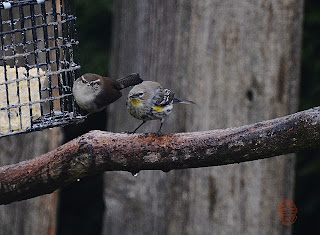American Robin can be seen all the year around in Oregon, but during the winter months, some can migrate to the south. As a result, I have not seen many of them lately.
When the Robin first arrived here, it was very cautious. As soon as it saw a shadow inside the patio glass door, it always flew away. But nowadays, it knows my backyard is a safe place.
When spring arrived, it enjoyed the birdbath.
Liking it so much that it became rather rude to say, "Back off! This is just for me."
Time flew fast when having fun. Soon it was the time to build a nest.
Later, one summer evening I came out to the backyard, and all of the sudden I heard someone's frantic calling. Amongst the grown veggies I could not see anyone.
Then, slowly this little one crawled out onto the trellis yelling for mum for a pick up. Probably the mummy fled when I came out (Lest assured the mum came back soon).
On a hot summer day, one felt so drowsy it conked out for a while.
Yesterday a Robin stopped over and looked well, busily cleaning up the feathers.
"I got so wet with this week's snow and rain. I wish I could take a nice bath like in the summer time."

















































